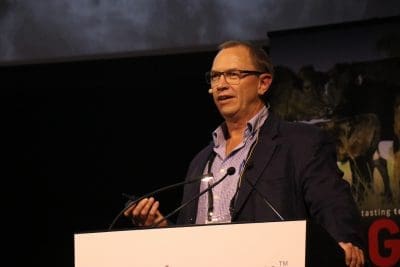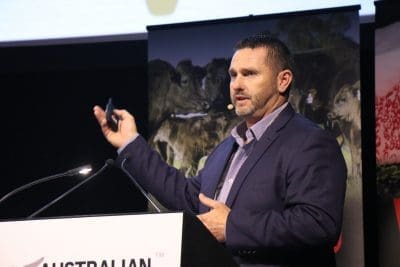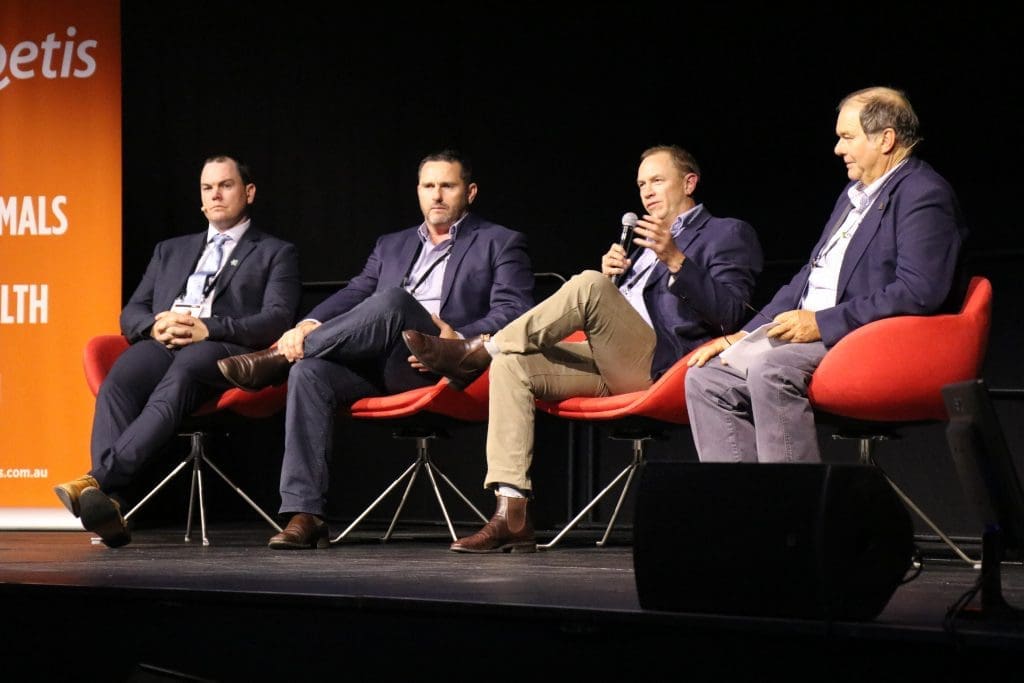
Panellists Steve Martin, Andrew Malloy, Berry Reynolds and moderator Peter Krause during the Future Wagyu Feeder Workshop.
DAY ONE of the 2019 Wagyu conference in Adelaide not only celebrated the breed’s 30 year history in Australia, but also looked to its future.
In an informative ‘Future Wagyu Feeder’ session, Mort & Co’s Berry Reynolds, Rangers Valley’s Andrew Malloy and Kerwee Feedlot’s Steve Martin shared their views on the current state of the market and provided insights into what lies ahead.
“Marbling, marbling, marbling”, the importance of collaborative relationships between lot feeders and suppliers, and the emergence of technology were among key messages throughout the session.
Critical elements to produce optimum feeder cattle
Like a three-legged stool, Mort and Co private client manager Berry Reynolds said each of the following elements were equally important: if one breaks, it all falls down.
The sire: With the large price corrections seen over the past 18 months (see recent Beef Central report on this topic) it was more important than ever to select sires with flexibility in their breeding to produce progeny that can go into various programs.
“I really believe we need to balance the pedigree of growth, carcase weight and mature cow weight and milk,” Mr Reynolds explained. Seedstock producers had to focus on the challenge of breeding high-marbling bulls with growth, and high-growth bulls with marbling – not easy, but the challenge was to find those outliers and replicate them.
The cow: “To me in beef production full stop, uniformity of a cow herd is just so critically important. If you have an up and down cow herd, you will get an up and down product right through to the slaughter floor,” he said.
He recommended using a mother with moderate growth and moderate milk, soundness of structure and good temperament, and stressed the importance of finding bloodlines with a history of marbling.
Management/Early Weaning: “I can’t stress enough the importance of weaning early,” Mr Reynolds said. “The benefits for the calf to be getting straight onto a ration of some description, to keep it moving on a rising plane of nutrition all the time are so important, but the benefits as a breeding unit are just unbelievably powerful. Your conception rates will improve next year, you’ll have a tighter calving, the list goes on and on.”
If you can’t early wean, creep feed: If producers could not early wean, they should creep feed, he said. “If you actually think of it as a cost, you have got to get rid of that mindset. It is an investment, and you have to think what is the return on your investment. The same is said for bunk training, yard weaning and low stress stock handling – all of those combine to give the lotfeeder an animal that is ready to go the minute it hits the feedlot.”
Over-feeding, just as detrimental as under-feeding
Mr Reynolds urged producers not to overfeed cattle to meet feedlot entry weights. Cattle coming in with too much condition, which had been pushed too hard as a producer tries to get cattle up to specifications, typically stopped performing after 200-250 days on feed, and were not as structurally good either. “This drought has highlighted the problem, but regulating their intake is imperative,” he said.
Benefits of close relationships
All three of the lotfeeders on the panel stressed the value for both parties of strong relationships between producers and lotfeeders, where the repeat flow of information leads to better performance and higher value over time. “There’s absolutely nothing to gain for me buying spot cattle, because I can’t feed information back to that producer knowing that I am going to get a better product in the next generation and the next generation,” Mr Reynolds said. “Once we have built a relationship, then we can really start moving forward and ramping up genetic gain.”
Grain pain pushes break-even to minimum marbling score 6
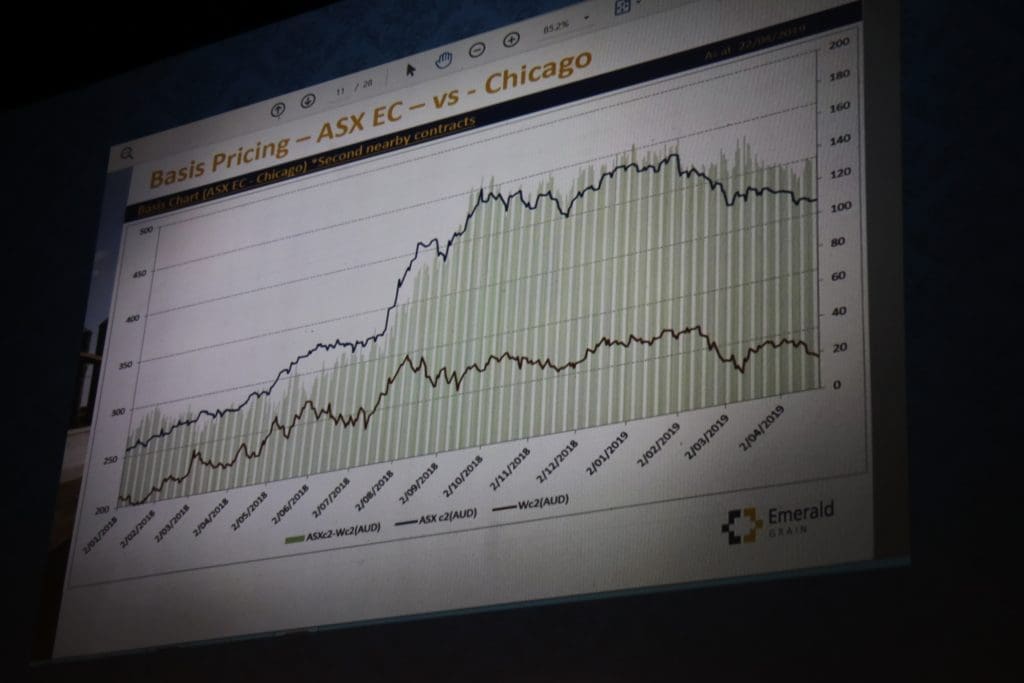
Chart documenting Australian grain price rises since January 2018 (blue line ASX wheat, red line Chicago wheat basis adjusted to AUD)
The single biggest factor affecting feedlot operators right now is the soaring cost of grain.
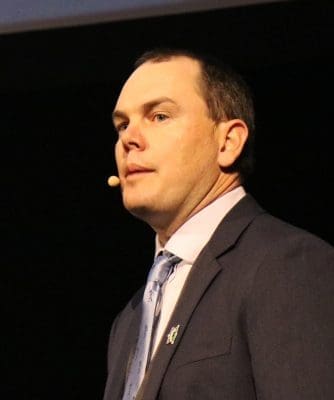 Kerwee general manager Steve Martin noted that this time last year, grain prices stood at around $280/t. Today they are about $450/t. Feeding Wagyu cattle for long 400 day periods further exacerbated the impact of this rising cost. Cattle exiting feedlots now have been partially exposed to these rising costs, but cattle being turned out of feedlots in coming months will have been fully-exposed to these added costs.
Kerwee general manager Steve Martin noted that this time last year, grain prices stood at around $280/t. Today they are about $450/t. Feeding Wagyu cattle for long 400 day periods further exacerbated the impact of this rising cost. Cattle exiting feedlots now have been partially exposed to these rising costs, but cattle being turned out of feedlots in coming months will have been fully-exposed to these added costs.
“With ration prices up here where they are at $450/t, we need cattle to achieve a marbling score of 6, just to break even,” he explained.
Shift towards higher marbling cattle
Livestock procurement management for Rangers Valley at Glen Innes, Andrew Malloy, said the feedlot had invested heavily in the development, expansion and positioning of F1s since mid-2012. “However, globally, we are experiencing a shift towards, and preference towards, higher marbling brands,” he said.
The bulk of F1s sit in the marbling score 4-6 range, several charts showing typical distribution of marbling scores demonstrated.
“The challenge with this scenario really comes down to the fact that with bulk of the cattle sitting in that 4-5-6 marble score bracket, in an F1 we’re not going to meet the customer needs or expectations for the future,” he said.
Caution against low marbling scores versing Angus product
Mr Malloy said top Angus genetics were now consistently and repeatedly achieving marbling scores in the 5-6 range. “This challenge is looming very fast,” he said “The improved Angus performance, coupled with the combined record high grain prices we’ve experienced in the last 12 moths – and the additional costs associated with feeding F1 Wagyu for an additional 100 days over the 270 day Angus programs – means we can no longer justify the price premium we saw through 2016-17 and the front end of 2018 for F1 Wagyu, unfortunately.”
Marbling, Marbling, Marbling
With dry conditions pushing more cattle toward feedlots, feed yards can be highly selective in the cattle they purchase. Mr Malloy said in the next 12 months, Rangers Valley would have a massive focus on the improvement of marbling outcomes, aided by the use of DNA technology (more on DNA below). “Increased use and strategic use of higher content Wagyu cattle through our WX brand will underpin our outcomes going forward,” he said.
Kerwee’s Steve Martin neatly summed up the prevailing sentiment with this line: “Moral of this story?…Don’t select on a single trait, but if you’re going to, select on marbling score.”
Marbling score and carcase weight consistency were by far the biggest factor driving Wagyu production systems, crossbred or otherwise, Mr Martin said.
Reducing heifers on feed, moving to higher content
As feedlots move to reduce the number of lower marbling Wagyu cattle they have on their inventory, both in response to economic requirements and customer demand, they are reducing the number of heifers on feed as well, because they produce more trim and a lower yield.
Facing the imperative to ensure every animal is as efficient and economically profitable as possible in the current high-cost environment, feedlots are also looking to remove F1 steers marbling 4 and 5 where possible, in favour of increased Wagyu content in order to achieve higher marbling performance.
“We are going to back off the lower content, and try to avoid feeding females, because we’re full and with limited space, everyone I put in I need to be more efficient,” Mr Martin said.
Question: What happens to producers with excess F1s?
What happens to producers with excess F1s and particularly excess heifers, a delegate asked from the floor.
“What do we do as Wagyu breeders, is there any plan in place for a lower price for those so people can offload those to upgrade their herds?”
The response from the panellists was that it may be best to sell them “before the money pit takes you too much deeper.”
Cattle that could not be sold into a branded Wagyu program for a premium would likely have to be sold on a grass grid.
In time, seasons will turn and feedlots will be crying-out for cattle, but at present low marbling score cattle were not economically viable, the panelists said.
Digital carcase grading technology
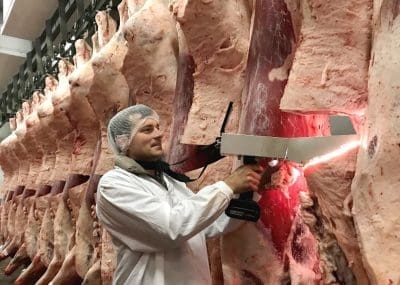 All three feedlot representatives agreed that the development of the MIJ (Meat Image Japan) objective carcase grading cameras being overseen by the Australian Wagyu Association would be a positive change for the industry. Mr Reynolds said replacing subjective measurement would help bull breeders to concentrate on improving key traits such as fineness of marbling in F1s, which account for about 70pc of commercial Wagyu production.
All three feedlot representatives agreed that the development of the MIJ (Meat Image Japan) objective carcase grading cameras being overseen by the Australian Wagyu Association would be a positive change for the industry. Mr Reynolds said replacing subjective measurement would help bull breeders to concentrate on improving key traits such as fineness of marbling in F1s, which account for about 70pc of commercial Wagyu production.
Mr Malloy said key benefits of the technology included uniform grading results across the industry, removing human error in assessment, and the ability to grade above BMS 9, which is currently as high as the AusMeat system goes. The MIJ camera will be able to identify BMS scores up to 12, as it does in Japan.
Drawbacks included connectivity issues within plants and chillers, the capital outlay and maintenance requirements, and the high cost per image at present, but these barriers will reduce in time, Mr Malloy predicted.
DNA tests will soon shape price feedlots pay for your cattle
The use of DNA testing to pre-screen the suitability of feedlot cattle prior to entry is likely to evolve rapidly over the next 12 months, each of the lotfeeders indicated.
Andrew Malloy said DNA testing may become a mandatory requirement to supply Rangers Valley in the future.
Why? Improved DNA testing, more service providers and lower costs were opening the technology up to greater use. Feedlots are currently working to explore how these emerging DNA tools can be used to assist in improving marbling outcomes and ensuring they are only feeding the right cattle. “That is cattle with the genetic merit to produce high marbling outcomes in the first place,” Mr Malloy explained.
Steve Martin said DNA testing would play a key role in value-based marketing in future.
“We haven’t quite worked out how we are going to screen them yet, but I would love to be able to run 12,000 hair samples through a DNA profiling machine and give you a genetic screened offering for what I think your steers are worth at feeder entry.
“That is where I believe the future will be. I don’t know how long it will take me to get there, but if we can take DNA measurements and determine that we feed none of these, we pay you a premium for these, the next step which we have already adopted is value-based marketing. That is an ability to pay you a bigger portion of this margin, because you are the ones making genetic gain.
“We already have probably 4000 cattle on feed which are under a value based marketing system, where those vendors will get a rebate on slaughter based on marbling score and carcase weight.
“Those vendors will get all their data back, and every season if they can increase their profitability for me, I will be sharing more of that back with them. That is what we’re looking to do, collaborative projects, and not have to compete on a spot market for cattle we don’t have a clue about.”
Andrew Malloy agreed that DNA testing opened the door to value-based marketing: “If we can eradicate those animals that are going to be at the bottom end of the scale, even if the price does go up, then we can afford to pay a bit more for the cattle that are going to perform. Ultimately that is what everybody needs to provide sustainability in the F1 production model.”
Feed conversion efficiency trials
In recent years Kerwee Feedlot has tested the feed conversion efficiency of the progeny of 51 Wagyu sires using the unique GrowSafe automated feed weighing bunks developed in Canada.
While the data is still yet to be fully cleaned up and analysed, Mr Martin said the trial is showing a feed conversion efficiency difference of about $200/t.
“What is coming out of our data is the genetic heritability, the variance within a population, is just as it was supposed to be with all the other breeds and Growsafe measurements, and you can select for feed efficiency without compromising growth and marbling,” he said.
‘That is not to say they’re a zero correlation, but there are absolutely outliers that are very efficient converters and have high marbling and high carcase weights.”
More on-farm data capture points in future
Andrew Malloy said another emerging trend will be the use of more data capture points on-farm to improve production outcomes. “An example of that is environmental data capture,” he said. “Weather conditions, nutrition, pre-feeding prior to feedlot entry, cows with calves invitro and weaning and backgrounding preparations. Both Dr Matt George and Dr John Doyle have raised these as areas of concern on impacting marbling outcomes in their respective presentations in Mackay last year also.”
“There is very little holistic data from our end at the feedlot that captures this and understands the breadth of these impacts, so this is something we really want to work on in the next 12 to 18 months,” he said.

